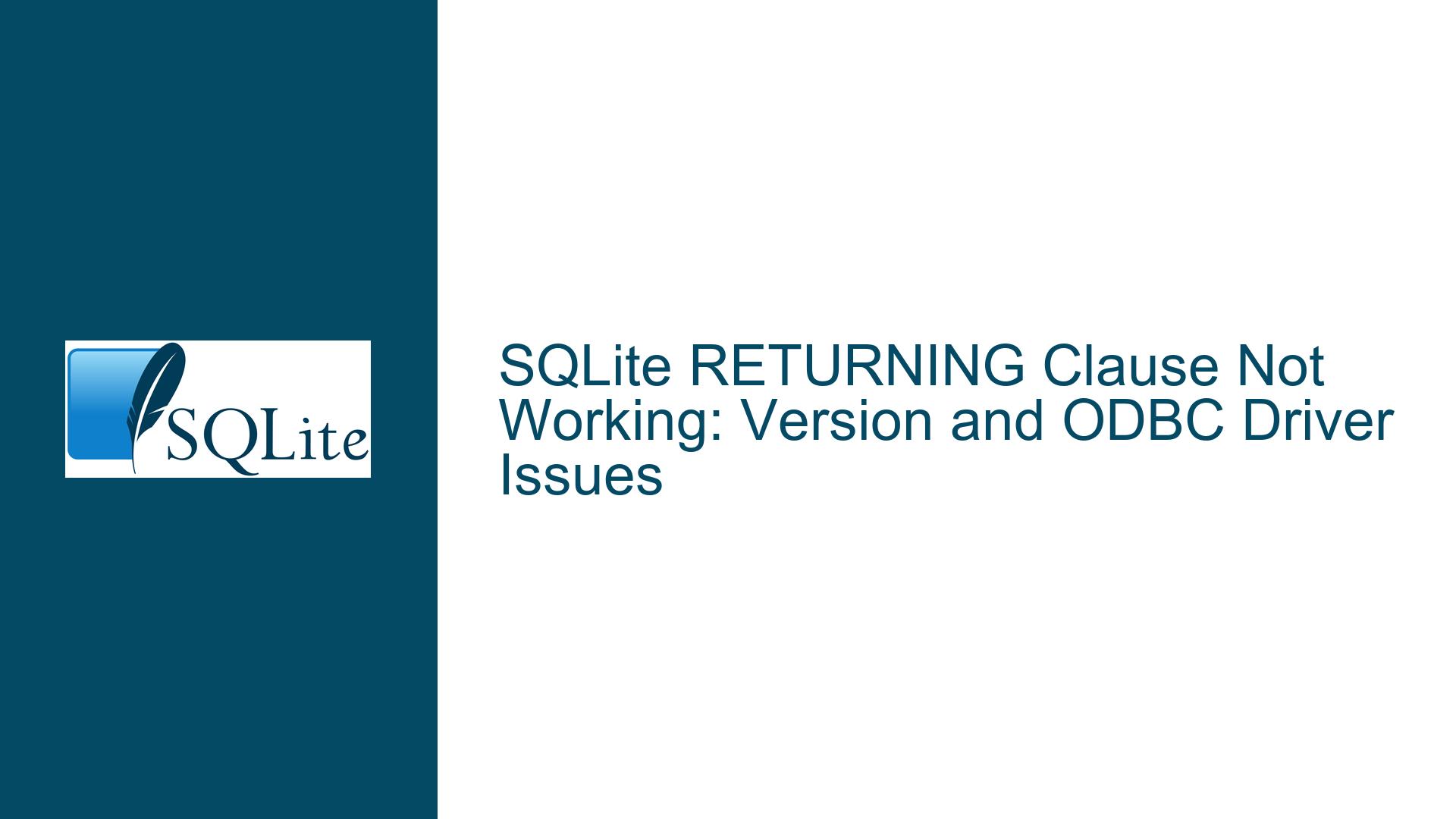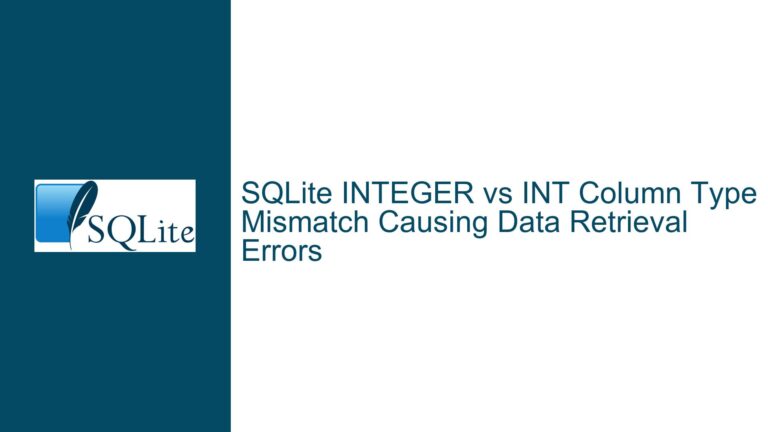SQLite RETURNING Clause Not Working: Version and ODBC Driver Issues
Issue Overview: RETURNING Clause Fails in SQLite with ODBC and Older Versions
The RETURNING clause in SQLite is a powerful feature that allows developers to retrieve the values of inserted, updated, or deleted rows directly within the same SQL statement. This feature is particularly useful for applications that need immediate feedback on the data modifications they perform. However, the RETURNING clause is not universally supported across all SQLite versions and interfaces, leading to confusion and frustration when it fails to work as expected.
In the context of this issue, the user is attempting to use the RETURNING clause in an INSERT statement through an ODBC connection in Visual Studio 2019. The user reports that the RETURNING clause does not produce any results, even when tested in DB Browser for SQLite. This suggests that the problem is not isolated to the ODBC interface but may be related to the underlying SQLite version or the way the ODBC driver interacts with SQLite.
The RETURNING clause was introduced in SQLite version 3.35.0, released on March 12, 2021. This means that any SQLite database or driver that predates this version will not support the RETURNING clause. Additionally, the ODBC driver being used is statically bound to SQLite version 3.32.3, which is older than the version that introduced the RETURNING clause. This version mismatch is a critical factor in why the RETURNING clause is not functioning as expected.
Furthermore, the user is working with Visual Basic (VB) in Visual Studio 2019 and has installed the SQLite NuGet package. However, the user is unsure how to leverage this package effectively, especially given the requirement to support both PostgreSQL and SQLite interchangeably via an INI file configuration. This adds another layer of complexity, as the user needs a solution that works seamlessly across both databases without significant code changes.
Possible Causes: Version Mismatch, ODBC Driver Limitations, and Development Environment Constraints
The primary cause of the RETURNING clause not working is the version mismatch between the SQLite database engine and the ODBC driver. The ODBC driver is statically linked to SQLite version 3.32.3, which does not support the RETURNING clause. This static binding means that even if the user upgrades the SQLite library on their system, the ODBC driver will continue to use the older version of SQLite, rendering the RETURNING clause unusable.
Another contributing factor is the development environment itself. The user is working with Visual Basic in Visual Studio 2019, which introduces additional constraints. While the SQLite NuGet package provides a managed wrapper around SQLite, it requires a certain level of familiarity with .NET development to use effectively. The user’s admission that their coding level is not sufficient to implement this solution highlights the challenges faced by developers who may not be deeply experienced with .NET or SQLite’s native API.
The requirement to support both PostgreSQL and SQLite interchangeably via an INI file configuration further complicates the issue. While ODBC provides a level of abstraction that allows for switching between different database systems by changing the connection string, this abstraction comes at the cost of reduced access to database-specific features. In this case, the RETURNING clause is a PostgreSQL feature that has been ported to SQLite, but its availability is contingent on the underlying database engine and driver support.
Additionally, the user’s attempt to use DB Browser for SQLite to test the RETURNING clause suggests that they may not be fully aware of the version requirements for this feature. DB Browser for SQLite is a useful tool for interacting with SQLite databases, but it does not automatically resolve version mismatches or driver limitations. The user’s observation that the RETURNING clause does not work in DB Browser either reinforces the conclusion that the issue is rooted in the SQLite version rather than the ODBC interface.
Troubleshooting Steps, Solutions & Fixes: Upgrading SQLite, Exploring Alternative Drivers, and Leveraging Managed Wrappers
To resolve the issue of the RETURNING clause not working in SQLite, the user must address the version mismatch and explore alternative solutions that accommodate their development environment and requirements. The following steps outline a comprehensive approach to troubleshooting and resolving this issue.
Step 1: Verify SQLite Version and Upgrade if Necessary
The first step is to verify the version of SQLite being used by the ODBC driver and the development environment. The user can do this by executing the following SQL command in their SQLite environment:
SELECT sqlite_version();
This command will return the version of SQLite currently in use. If the version is older than 3.35.0, the RETURNING clause will not be supported. In this case, the user must upgrade to a newer version of SQLite.
However, upgrading SQLite is not as straightforward as it may seem, especially when dealing with an ODBC driver that is statically linked to an older version. The user must ensure that the ODBC driver is either updated to a version that supports SQLite 3.35.0 or replaced with a driver that dynamically links to the SQLite library.
Step 2: Explore Alternative ODBC Drivers
If the current ODBC driver cannot be updated to support SQLite 3.35.0, the user should explore alternative ODBC drivers that offer dynamic linking to the SQLite library. One such option is the SQLite ODBC driver provided by Christian Werner, which allows users to specify the path to a custom SQLite3.DLL file. This flexibility enables the user to use the latest version of SQLite, even if the ODBC driver itself is not updated.
The user can download the appropriate ODBC driver for their system (32-bit or 64-bit) from the following links:
- 32-bit ODBC driver using SQLite3.DLL in Windows System Folder
- 64-bit ODBC driver using SQLite3.DLL in Windows System Folder
After installing the driver, the user must ensure that the SQLite3.DLL file corresponding to SQLite 3.35.0 or later is placed in the Windows System Folder or another location specified by the driver configuration.
Step 3: Leverage Managed Wrappers for SQLite
If the user is unable to resolve the issue through ODBC, they should consider using a managed wrapper for SQLite, such as the System.Data.SQLite library available via NuGet. This library provides a .NET interface to SQLite, allowing the user to interact with the database using familiar .NET classes and methods.
To use System.Data.SQLite, the user must first install the NuGet package in their Visual Studio project. This can be done via the NuGet Package Manager or by running the following command in the Package Manager Console:
Install-Package System.Data.SQLite
Once the package is installed, the user can create a connection to the SQLite database using the SQLiteConnection class and execute SQL commands using the SQLiteCommand class. The RETURNING clause can be used in the same way as in native SQLite, provided that the underlying SQLite library supports it.
Here is an example of how to use the RETURNING clause with System.Data.SQLite in VB.NET:
Imports System.Data.SQLite
Module Module1
Sub Main()
Dim connectionString As String = "Data Source=mydatabase.db;Version=3;"
Using connection As New SQLiteConnection(connectionString)
connection.Open()
Using command As New SQLiteCommand("INSERT INTO t (c) VALUES ('new value') RETURNING c;", connection)
Using reader As SQLiteDataReader = command.ExecuteReader()
While reader.Read()
Console.WriteLine(reader("c").ToString())
End While
End Using
End Using
End Using
End Sub
End Module
This code snippet demonstrates how to insert a new row into a table and retrieve the inserted value using the RETURNING clause. The SQLiteDataReader class is used to iterate over the results returned by the RETURNING clause.
Step 4: Implement Database Abstraction for PostgreSQL and SQLite Interoperability
Given the user’s requirement to support both PostgreSQL and SQLite interchangeably, it is essential to implement a database abstraction layer that can handle the differences between the two databases. This abstraction layer should provide a consistent interface for executing SQL commands and retrieving results, regardless of the underlying database.
One approach to achieving this is to use the Factory design pattern to create database-specific implementations of a common interface. For example, the user can define an IDatabase interface with methods for executing queries and retrieving results, and then create separate implementations for PostgreSQL and SQLite.
Here is an example of how this abstraction layer might be implemented in VB.NET:
Public Interface IDatabase
Function ExecuteQuery(query As String) As DataTable
Function ExecuteNonQuery(query As String) As Integer
Function ExecuteScalar(query As String) As Object
End Interface
Public Class PostgreSQLDatabase
Implements IDatabase
Private connectionString As String
Public Sub New(connectionString As String)
Me.connectionString = connectionString
End Sub
Public Function ExecuteQuery(query As String) As DataTable Implements IDatabase.ExecuteQuery
Using connection As New NpgsqlConnection(connectionString)
connection.Open()
Using command As New NpgsqlCommand(query, connection)
Using adapter As New NpgsqlDataAdapter(command)
Dim dataTable As New DataTable()
adapter.Fill(dataTable)
Return dataTable
End Using
End Using
End Using
End Function
Public Function ExecuteNonQuery(query As String) As Integer Implements IDatabase.ExecuteNonQuery
Using connection As New NpgsqlConnection(connectionString)
connection.Open()
Using command As New NpgsqlCommand(query, connection)
Return command.ExecuteNonQuery()
End Using
End Using
End Function
Public Function ExecuteScalar(query As String) As Object Implements IDatabase.ExecuteScalar
Using connection As New NpgsqlConnection(connectionString)
connection.Open()
Using command As New NpgsqlCommand(query, connection)
Return command.ExecuteScalar()
End Using
End Using
End Function
End Class
Public Class SQLiteDatabase
Implements IDatabase
Private connectionString As String
Public Sub New(connectionString As String)
Me.connectionString = connectionString
End Sub
Public Function ExecuteQuery(query As String) As DataTable Implements IDatabase.ExecuteQuery
Using connection As New SQLiteConnection(connectionString)
connection.Open()
Using command As New SQLiteCommand(query, connection)
Using adapter As New SQLiteDataAdapter(command)
Dim dataTable As New DataTable()
adapter.Fill(dataTable)
Return dataTable
End Using
End Using
End Using
End Function
Public Function ExecuteNonQuery(query As String) As Integer Implements IDatabase.ExecuteNonQuery
Using connection As New SQLiteConnection(connectionString)
connection.Open()
Using command As New SQLiteCommand(query, connection)
Return command.ExecuteNonQuery()
End Using
End Using
End Function
Public Function ExecuteScalar(query As String) As Object Implements IDatabase.ExecuteScalar
Using connection As New SQLiteConnection(connectionString)
connection.Open()
Using command As New SQLiteCommand(query, connection)
Return command.ExecuteScalar()
End Using
End Using
End Function
End Class
With this abstraction layer in place, the user can easily switch between PostgreSQL and SQLite by instantiating the appropriate database class based on the configuration in the INI file. This approach ensures that the application remains flexible and maintainable, even as the underlying database technology changes.
Step 5: Test and Validate the Solution
After implementing the above steps, the user must thoroughly test the solution to ensure that the RETURNING clause works as expected and that the application can seamlessly switch between PostgreSQL and SQLite. This testing should include:
- Verifying that the
RETURNINGclause returns the correct values in SQLite. - Ensuring that the ODBC driver or managed wrapper correctly interacts with the SQLite database.
- Testing the database abstraction layer to confirm that it handles both PostgreSQL and SQLite queries correctly.
- Validating that the application can read the database configuration from the INI file and instantiate the appropriate database class.
By following these steps, the user can resolve the issue of the RETURNING clause not working in SQLite and achieve their goal of supporting both PostgreSQL and SQLite interchangeably in their application.






